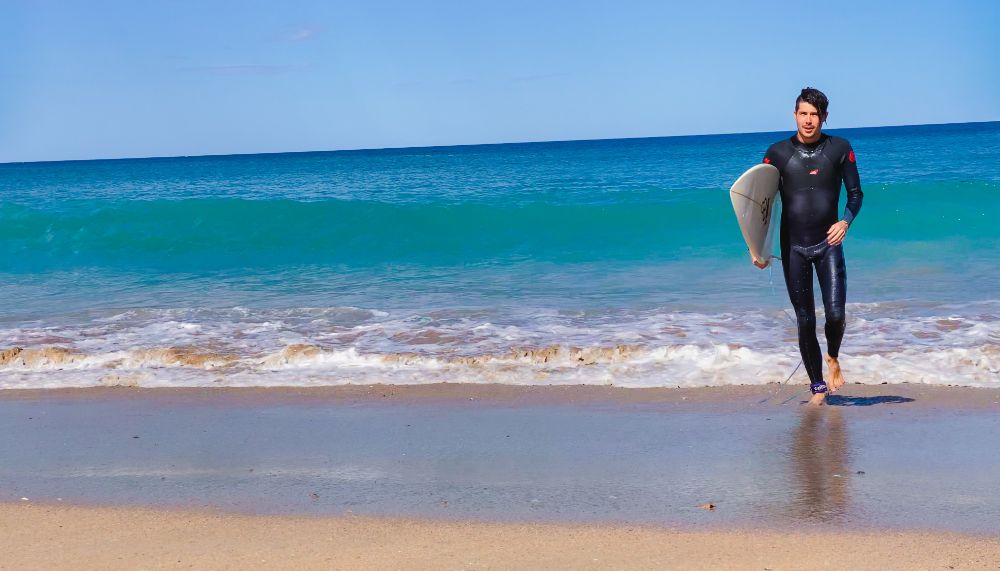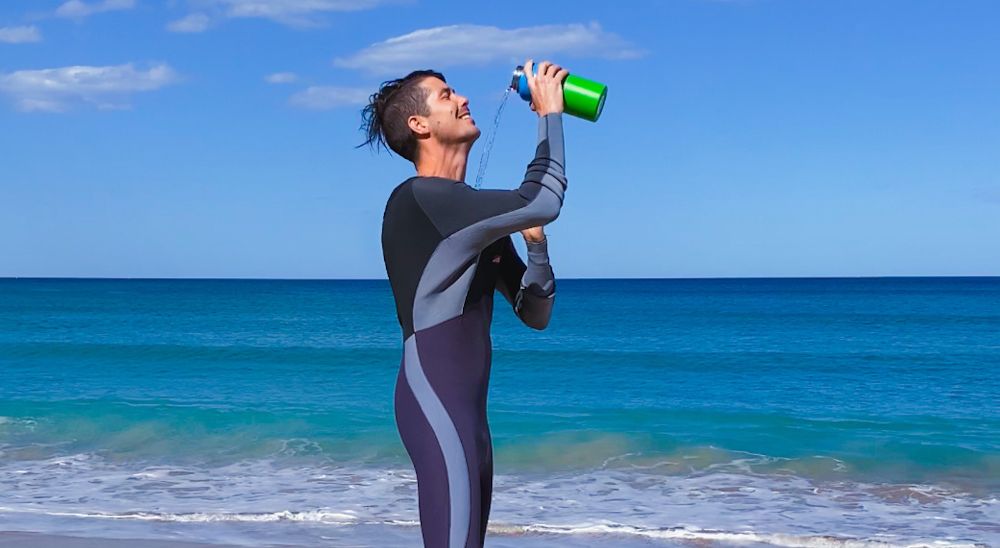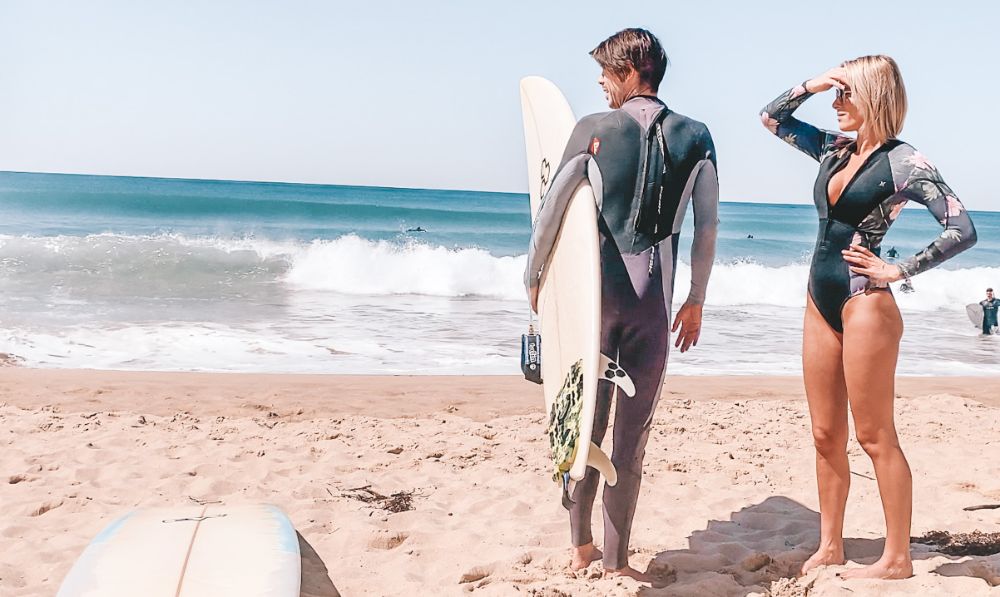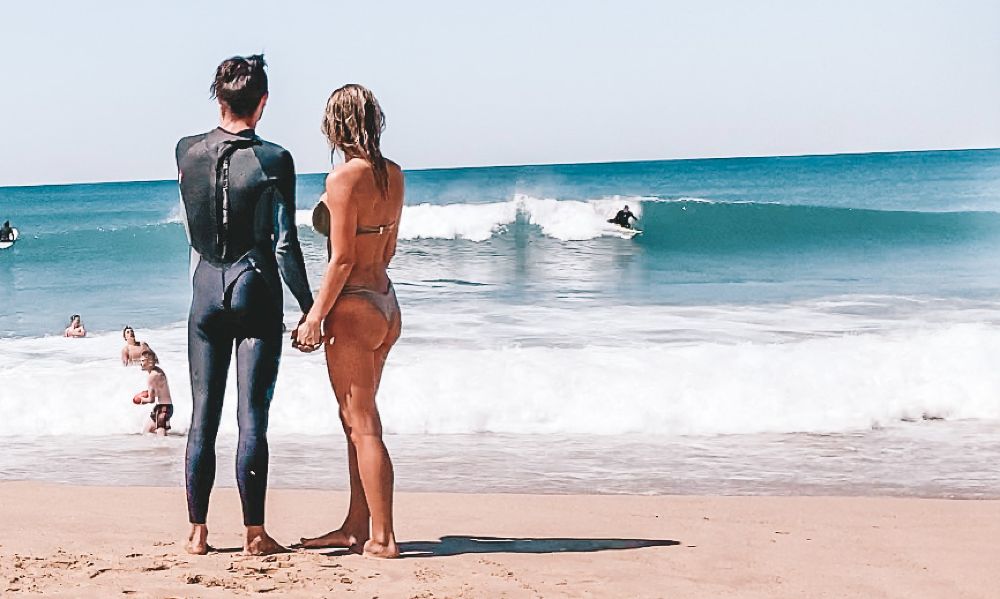When looking for ways to say warm in cold water you're likely going to be looking at both wetsuits and dry suits.
If you've never worn a wetsuit before it can be confusing as to how they work and you may want to know if wetsuits keep you dry or not?
Wetsuits do NOT keep you dry. While they are made out of waterproof neoprene they let in a thin layer of water through the neck, wrists, ankles and zippers. Anything you wear under a wetsuit will get completely wet.
This thin layer of water is quickly warmed by your body and the wetsuit is designed to be tight and not let much water in, so your body stays warm and is only exposed to a small amount of cold water at a time.
If you're having trouble remembering then it's right in the name “wet-suits” allow you to get wet whereas “dry-suits” keep you completely dry.
Are Wetsuits Waterproof? Do They Keep You Dry?

Wetsuits are made from waterproof materials, but they don't keep you dry and anything you were under your wetsuit will get wet.
The inner layer of wetsuits is water proof and will actually keep water out and away from your body.
If you're wearing clothes under your wetsuit and someone throws a bucket of water at you then your clothes will likely stay completely dry.
However, when you're completely submerged in water wetsuits won't keep you dry because water will enter into your wetsuit through your neck, zipper, wrists and ankles.
I'll often wear my wetsuit with nothing underneath as I find this is the most comfortable and keeps me toasty warm but some people like to wear swimmers or rash vests under their wetsuit for comfy, privacy or to stay warm.
However, I recommend you don't wear bulky clothing under your wetsuit. Firstly, it'll get wet which can make you colder but also you won't look good in your wetsuit and you won't be comfortable if the clothes bunch up under your wetsuit
How Does Water Get Into Wetsuits? Why Do You Get Wet in a Wetsuit?

Wetsuits are made from neoprene closed cell foam which is actually waterproof.
Neoprene is a rubber that is filled with tiny nitrogen bubbles. It's actually the nitrogen bubbles that do the insulating and keep you warm.
But if neoprene is water proof how does water get into your wetsuit and why does a wetsuit make you wet?
While wetsuits are tight fitting and made from water proof material they let in water through the neck, zipper, wrists and ankles. Because the wetsuit is so tight only a thin layer of water stays inside you wetsuit and your body warms this up quickly.
When you're surfing, scuba diving or whatever you're doing the water in your wetsuit is constantly being drained out of your wetsuit and replaced with fresh cold water.
In a good wetsuit this will happen at a slow rate that it's hardly noticeable and your body will heat up the water rather quickly.
In a cheaper wetsuit or one that doesn't fit properly more water will flow through your suit (known as the dreaded flush) and this will expose your body to more cold and it will cause you to get cold quicker.
This is why a tight fitting wetsuit is so important. Going too big will make it easier for water to get into your wetsuit and fill it up.
Do Wetsuits Need To Be Wet To Keep You Warm?

It's a common misconception that wetsuits work to keep you warm by allowing a thin layer of water between your skin and the wetsuit which your body warms up and that keeps you warm.
This is not the case at all and your wetsuit will actually keep you warmer if it's completely dry.
Wetsuits are made from neoprene foam, which contains thousands of tiny nitrogen bubbles. These bubbles make it hard for heat to move through your wetsuit.
This traps your body heat inside your wetsuit and stops the cold water from sapping the energy away from your skin.
Wetsuits don't need water to work and if you've ever stood in the sun in a wetsuit on a warm day then you'll find you get hot really quickly.
In fact, one of the best ways to stay warm in a wetsuit is to put it on a while before you get in the water. This heats up your body and the cold water becomes a relief for you.
How Do Wetsuits Work?

One of the biggest myths out there is that wetsuits keep you warm because they allow a thin layer of water into the wetsuit which your body heats up and that's what keeps you warm.
While this does happen this is not why wetsuits keep you warm. So how exactly do wetsuits work to keep you warm.
There is a great video on this which I'll link up below but here's the basic details.
- Wetsuits are made from closed cell neoprene foam which is a great insulator
- This foam is filled with thousands of tiny nitrogen bubbles
- Heat struggles to move through the neoprene air bubbles and so it traps in your body's warmth and keeps away the coldness of the water
- A wetsuit will keep your body hot even when it isn't wet
- The thicker the neoprene the more your wetsuit will keep you warm, but the more restricted you will be in your movement (like how a thicker cooler keeps ice longer)
- Wetsuits have an outer layer of water and abrasion resistant material to protect the wetsuit and make it last longer
- Water does get into your wetsuit but because the wetsuit is so tight only a tiny thin layer of water stays inside your wetsuit which your body quickly warms up to body temperature
As you spend more time submerged in water then cold water from the outside will slowly leak into your wetsuit as warm water flushes out the bottom. You body has to heat this new cold water and over time this will sap your energy and you will get cold.
Can You Make a Wetsuit Waterproof?

It would probably be possible to make a wetsuit waterproof by adding rubber cuffs to your ankles, wrists and neck but this isn't really how they are designed.
Dry suits are usually made from a lighter waterproof fabric with thick rubber cuffs to keep out the water. This design allows you to wear warm clothes underneath your dry suit and get your warmth from your clothes, not from the dry suit itself.
However, some dry suits do use insulating foam and are both water proof and help to keep you warm.
You can also get semi-dry suits which are basically wetsuits with thick rubber cuffs to let in a lot less water than a regular wetsuit.
Generally speaking most people use wetsuits when the water is fairly warm but as the water or wind chill gets to extreme temperatures then dry suits are required as they can keep you warmer than wetsuits do because you're not getting exposed to any cold water at all.
Below is a rough guide of what thickness and type of wetsuit you may need based off the water temperature. The colder the temperature the thicker the wetsuit and the more likely it is you'll want to add booties, gloves or a hood for more protection from the cold.
| Water Temp Range ºF (ºC) | Wetsuit Thickness | Recommended Wetsuit Type | Seal Type |
|---|---|---|---|
| >72ºF (>22ºC) | N/A | Rashguard | N/A |
| 65-75ºF (18-24ºC) | 0.5 – 2/1 mm | Top / Spring Suit / Shorty / Short John | N/A |
| 62-68ºF (16-20ºC) | 2 – 3/2 mm | Spring Suit / Steamer (Full Suit) | Flatlock |
| 58-63ºF (14-17ºC) | 3/2 – 4/3 mm | Steamer, Boots | Sealed |
| 52-58ºF (11-14ºC) | 4/3 – 5/4/3 mm | Steamer, Boots, Gloves, Hood | Sealed + Taped |
| 43-52ºF (6-11ºC) | 5/4 – 5/4/3 mm | Steamer, Boots, Gloves, Hood | Sealed + Taped |
| <42ºF (<6ºC) | 6/5 – 7 mm | Steamer, Boots, 3 Finger Gloves, Hood | Sealed + Taped |




